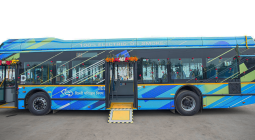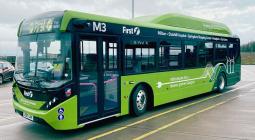Oxford becomes UK’s electric bus capital as 159 vehicles join fleet
Private operators are guaranteed faster journey times by the council in return for investment
Oxford is launching an electric fleet that will make the city one of the UK’s leading adopters of zero-emission buses.
The 159 new battery-powered buses will give Oxford more electric buses per capita than other cities including London, Glasgow and Leicester, under a pioneering arrangement in which the council will guarantee private operators faster journey times in return for investment.
From Monday, the first buses will officially enter service after a ceremony to mark the launch. Only buses that are zero-emission will be allowed within the city when the entire fleet is operational, with more restrictions on other types of traffic to cut congestion as well as improve air quality.
Just over half the money for the £82.5m scheme has come from Go-Ahead and Stagecoach, who put in £43.7m to buy the vehicles, with the rest from the council and government. Oxfordshire county council received a £32.8m grant from the Department for Transport’s £500m Zebra scheme to fund zero-emission buses.
The partnership, in which both Go-Ahead and Stagecoach electric buses will be rebranded in the same livery, will be underpinned by further traffic measures in the city to reduce bus journey times by at least 10% compared with 2019 speeds – a contractual commitment from the council to ensure the investment is viable for the private companies.
The city already has a number of “bus gates”, which prohibit most other vehicles, and more traffic filters will be introduced by the end of 2024 to push people towards public transport or active travel where possible.
Oxford has already implemented several low traffic neighbourhoods (LTNs), which have been the focus of heated protests by campaigners and conspiracy theorists.
So far, increased traffic on the edge of LTNs has slightly slowed bus speeds in the city, according to Luke Marion, managing director of the Go-Ahead-owned Oxford Bus Company, who said the company nevertheless supports the zones as a “key part of the jigsaw”. Accompanying measures to cut traffic had been delayed, partly because of major roadworks, he said, but “once the traffic filters come in, that will cease to be such a problem.”
Oxford Bus Company, which will provide 104 of the 159 mostly double-decker electric buses, has installed a charging hub at its Cowley House depot that provides enough electricity to charge its entire fleet to drive 170 miles daily.
The first of its electric buses, serving Oxford Brookes University, are already on the roads but Marion described Monday’s launch as a “historic moment in our journey towards transforming our city services to electric”.
There are 2,776 battery-operated buses in service in the UK, according to Zemo, a zero-emissions transport body, with more than 1,400 in London and nearly 500 in Scotland.
The Oxford launch comes just as Go-Ahead has been forced to temporarily withdraw a small fleet of electric buses in south London after one caught fire on Thursday. Transport for London said the move was a precaution affecting only one model serving a particular route.
The move to make all Oxford buses zero-emission comes in contrast to the controversial decision to build the new East-West railway line between Oxford and Cambridge using diesel trains, rather than electrifying the track.
Cover photo: One of Oxford’s ‘bus gates’, which prohibit most other vehicles. Photograph: GoAhead





